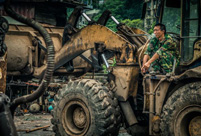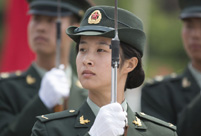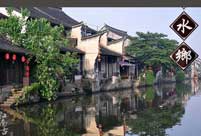 Chinese Kung Fu charms Silicon Valley
Chinese Kung Fu charms Silicon Valley
 Tranquil Yankou ancient town
Tranquil Yankou ancient town
 Lake Geneva: A show of swans
Lake Geneva: A show of swans
 Beautiful sunset over the Irtysh River
Beautiful sunset over the Irtysh River
 Qingjing Mosque: Witness of the ancient Maritime Silk Road
Qingjing Mosque: Witness of the ancient Maritime Silk Road
 Neiliansheng – more than 100 years of fashion
Neiliansheng – more than 100 years of fashion
 Golden retriever feeds baby African lions
Golden retriever feeds baby African lions
 Strange rocks in Lama Mountain
Strange rocks in Lama Mountain
 First overseas "China-standard" electric railway laid
First overseas "China-standard" electric railway laid
 College graduate launches organic agricultural cooperative in hometown
College graduate launches organic agricultural cooperative in hometownBeautiful riverside view of Lhasa. Photograph by Chen Jiajia
Isn’t Lhasa beautiful?
The spacious streets, being expanded and extended every now and then, have amplified the urban structure; the mushrooming high-rises exude with strong artistic and modern symbols; beautiful parks and fields of green echo bird chirps, pavilions and numerous sculptures…
Visitors here invariably have such comments: the blue sky, clear water and new urban appearance themselves make up the beautiful scenery, not to mention the unpolluted air. The city is definitely the place that makes people reluctant to leave. It’s simply gorgeous!
Now, this ancient and beautiful city is expressing its own identity during the construction process with its extremely tender urban language and the most exquisite urban details.
The beauty cannot come true without the scientific decisions of the Lhasa Municipal Party Committee and the Municipal Government: to implement the strategy of “building the environmental city” in an all-round way is the shared contribution of the 830,000 Lhasa people of all ethnicities, all because they love this land so much.
Comply with public opinion: explore “mountain planting”
Lhasa belongs to the plateau monsoon semiarid climate. The region boasts thin air, long sunshine duration, little rainfall, and high plant transpiration, which makes Lhasa short of natural vegetation and large wild trees, not to mention its arid mountains where barely any plant grows.
Ms. Xu, who has lived in Lhasa for almost half of her life, said: “I once had a dream that all the mountains around Lhasa became green like Nyingchi. That appeared so amusing when I woke up!”
The scenario in Ms. Xu’s dream is not strange anymore, because right now the mountains in Lhasa have all become green with trees, while the vast plateau is also green all over. This is the China dream and the Tibet dream for people of previous generations!
Currently, the urban green coverage rate in Lhasa has increased from 31.46% in 2007 to 37.6% right now; the green coverage of the urban built-up area has risen from 30.56% to 32.8%; the per capita green area has enlarged from 3.91 square meters to 9.6 square meters.
With the dream of planting trees on the mountains, in 2008, Lhasa invested RMB15.479 million to implement its project of the first forest building, in order to explore the experience of building forest in the mountains. Now after five years of the implementation, the survival rate of the forest has reached more than 80%. In 2012, Lhasa decided again to implement the green experiment on the southern mountains, and for the first time it started to plant trees in autumn on a large scale.
On hearing the news, people of various ethnicities and walks of life invariably felt excited and motivated. The sacred city of Lhasa has started a new wave of greening its homeland.
The person in charge of the afforestation section at the Greening Forestry Bureau of Lhasa commented that “it is the first time for Lhasa to implement the ‘mountain planting’ project, since there are not precedent practice, scientific result, nor testified technology to provide guidance, we are surely ready to confront difficulties and accept failures from the mental aspects. Now no matter how challenging the difficulties or problems are, we will continue move forward unflinchingly.”
To deal with the three most challenging problems of soil, water and saplings, Lhasa has come out with its own ‘prescripts’ while marching forward during the practice with innovation and exploration:
The higher the altitude is, the less natural soil there is. In order to solve the soil problem, the first thing to do is to transport the soil underfoot up to the mountain. In places where there are more stones than soil, stones are used to fill the pits first before the soil is layered over. When it comes to soil erosion due to rainy season or over irrigation, each pit needs to be filled and fertilized again. Besides such measures and the traditional methods of improving soil quality, advanced technologies are also brought in to improve soil quality to make it more plant friendly.
In order to plant trees on the mountains, the first thing to do is to solve the irrigation problem. After repeated tests and proving Lhasa adopted the trickle irrigation methodologies from Israel so that every drop of water can be utilized. This greatly improved the irrigation efficiency and provided great foundation for plant water supply.
For the saplings, Lhasa utilized the landform of the mountains and the land conditions during its practice, in order to exploit the advantages of local plants to the full. They chose to preserve the predominance of local saplings when scientifically bringing in and localizing foreign kinds of saplings, besides that, bare-rooted seedlings were replaced by container-grown seedlings and transplantone was also used to increase the survival rate of the saplings and protect the natural plants.
By now, about 1,000 mu of the southern mountains has finished the greening process, of which 1,221,100 saplings of various kinds and about 1,196,600 trees and shrubs were planted. Currently, the newly grown trees are growing soundly with vibrancy.
Last year, the Tibetan Autonomous Region planned and started the greening projects in and beside the valleys, investing RMB10 billion for the next 20 years to come. With the great financial support and such prescription, we have full reasons to anticipate and strive for the future: luxuriantly green mountains amid the snow, azure sky and white clouds… with the guidance of the “dragon head” of Lhasa, places in Tibet will become greener and more beautiful!
 |
 Opening ceremony of 67th Cannes Film Festival
Opening ceremony of 67th Cannes Film Festival Pulse of Xiamen - Int'l Yoga art festival in May
Pulse of Xiamen - Int'l Yoga art festival in May Photo story: Life of a scrap metal recycle worker
Photo story: Life of a scrap metal recycle worker Training of the PLA's first female honor guard
Training of the PLA's first female honor guard China's 10 must-see animations
China's 10 must-see animations Female bodybuilders show their beauty of fitness
Female bodybuilders show their beauty of fitness A taste of Harbin cuisine
A taste of Harbin cuisine A bite of Jiang Nan
A bite of Jiang Nan Who is China's campus beauty queen?
Who is China's campus beauty queen? 8 great movies to watch with your mom
8 great movies to watch with your mom China's most luminous celebrities
China's most luminous celebrities Newly recruited police in Hetian hold drill
Newly recruited police in Hetian hold drill  Bird-men compete flying in Hong Kong
Bird-men compete flying in Hong Kong  The 'Chinese Dad'
The 'Chinese Dad' Shanghai locals bid farewell to childhood memories
Shanghai locals bid farewell to childhood memoriesDay|Week|Month